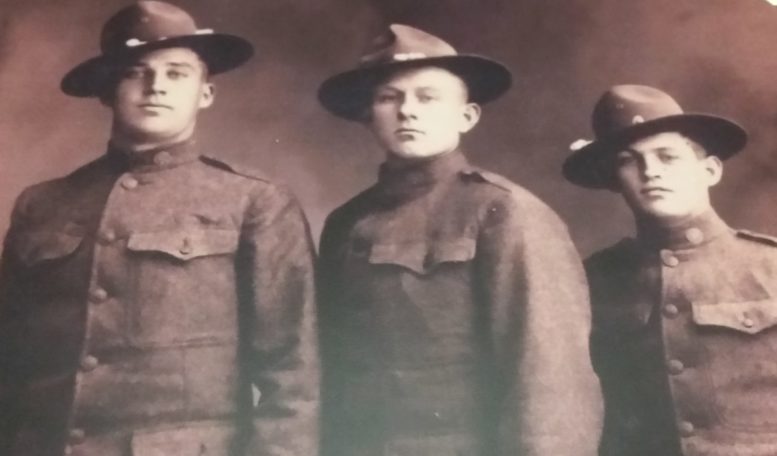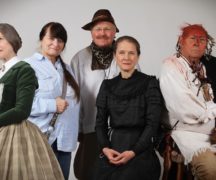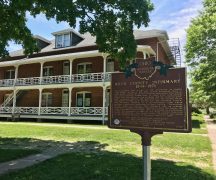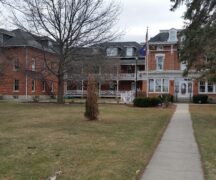By JAN LARSON McLAUGHLIN
BG Independent News
A century ago, American doughboys were being sent overseas to fight in World War I. Wood County farm boys, many who had never been outside the county, were shipped over to battle in the trenches.
To commemorate the county’s involvement in WWI, the Wood County Historical Center has dedicated its entire museum space this year to the “War to End All Wars.” The exhibits look at the war overseas, the local boys who served their nation, and the families they left behind here in Wood County.
Many of the items on display have been loaned to the museum by local families, whose ancestors served. Others have come from American Legion posts in the county.
“We are very, very grateful,” said Holly Hartlerode, curator at the historical center. “We are here to share story.”
Many of the legion posts throughout the nation are dwindling in memberships but are teeming with historical artifacts of past members. “This is important,” Hartlerode said. “We can become a depository for their memories.”
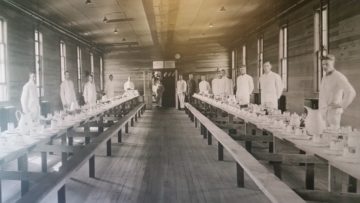
Photo of a WWI mess hall
The WWI exhibit is the first time that the entire museum has been devoted to one period in history. The self-guided tours start with an explanation of how WWI started. Because the war seems almost like ancient history to some younger visitors, the exhibit includes some interactive portions to keep the attention of guests.
One of the first rooms on the tour offers a game with maps, portraits of world leaders and questions about who are allies and who are enemies.
“The average person was affected by the actions of these fellows,” Hartlerode said pointing to the portraits of the world leaders hanging on the wall. Though she finds the war fascinating, the curator is aware that interactive exhibits help keep others interested.
“How do we not bore people to death when explaining the political aspects of the war,” she said.
The exhibit explains the U.S. reluctance to get involved in WWI, with Woodrow Wilson sitting on the sidelines for nearly three years until two key events occurred. First was Germany’s unrestricted submarine warfare that resulted in the sinking of the Lusitania with 128 Americans on board. The second was the interception of the Zimmermann Telegram, in which Germany tried to persuade Mexico to wage war against the U.S. in exchange for Germany helping Mexico regain territories lost to the U.S.
But with America being a nation of immigrants, many from the countries already fighting, Wilson tried to unite Americans with patriotism rather than their national loyalty to homelands overseas.
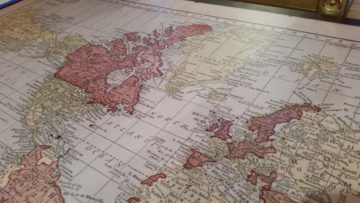
Interactive map exhibit at museum
So museum visitors are asked to chart out their ancestry on a huge map – using white pins to show their residencies, red pins to chart their maternal homelands, and blue pins to show their paternal origins. Many Wood County residents hailed from Germany.
With the passage of the Selective Service Act – which covered men ages 18 to 45 – approximately 2.8 million American men were drafted into service. By the summer of 1918, the nation was sending 10,000 soldiers to France every day.
The museum display cases are full of loaned memorabilia brought home by some of those local soldiers. There are ammunition belts, gas masks, medals, a machine gun, German helmets, plus small books carried in soldiers’ pockets. Those texts include prayer books, tiny training manuals and books with basic French words.
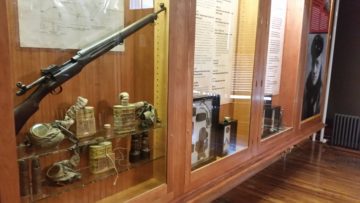
War memorabilia brought back home by local soldiers
There are also German propaganda posters – spreading the word though at a slower speed than social media today.
One room does its best to put museum visitors in the trenches with soldiers. With the help of the BGSU Theater Department, trench-like construction twists its way through a room, with tall mud-colored walls propped with branches and topped with barbed wire.
“All that’s missing is the water, rats and bodies,” Hartlerode said.
It’s the trenches that led to WWI stretching on for four years, she explained.
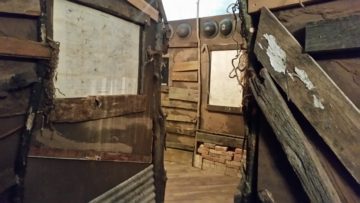
Trench room gives museum visitors an idea of where soldiers lived and fought
“They thought it would be a quick war,” she said. But for the first time, the soldiers did not fight in the Napoleon style of lining up across from each other and shooting. Advanced weaponry, like machine guns, made that type of warfare far too dangerous. This war they dug in deep and fought from protected positions. Maps brought home by local soldiers are posted on the “trench” walls in the museum, showing trenches that stretch from the North Sea coast of Belgium to the southern Swiss Alps in France.
The German trenches were better constructed, since Britain and France tried to take the offensive while Germany dug in to defend the occupied territories. So the allies’ trenches often had drainage issues, which caused “trench foot” among the troops. “That’s why the Red Cross was always knitting socks,” Hartlerode said.
While the main floor of the museum focuses on the overall war, the second floor is dedicated to Wood County soldiers and their families back home.
Huge black and white photographs blown up to cover entire walls show the young recruits standing in front of the Wood County Courthouse. One room has binders of names of local men called on to become soldiers, which visitors can page through to look for relatives who may have served in the war.
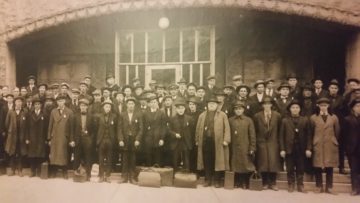
Wood County men pose in front of courthouse before being shipped overseas
A rack of aging uniforms, loaned to the museum, hang for visitors to view. Many were worn by men who had barely been off their farms, let alone overseas.
Then there are rooms focusing on how families back at home survived the war. There are Blue Star Flags, proudly displayed by families with soldiers overseas, stories about rationing, War Savings Stamps, and Victory Gardens.
One room is dedicated to the American Red Cross and its role making bandages and other necessities for troops. There is a mail room, displaying letters sent back home from soldiers and giving visitors another chance to interact.
“You can fill out a draft card and put it in the mail slot,” Hartlerode said.
Another room is filled with enlarged newspaper pages with huge headlines updating folks back home about the war.
Big posters promoting Liberty Bonds show how the war was financed. The posters, on loan from the BGSU Popular Culture Department, make sure to show a glamorous – not gory – image of the war.
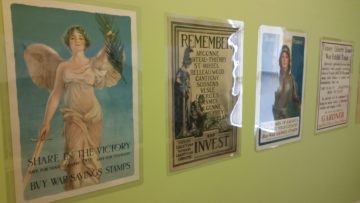
Liberty Bonds posters show how the war was financed
“They are merging art and politics and economics and military,” Hartlerode said. “There was no TV, no radio. This is how they got their message out.”
There is also old movie seating in front of a WWI documentary for visitors to view the gritty black and white images.
Since WWI was the last war in which horses were used by troops, the museum has information on some local veterinarians who offered their services overseas. “We had a few vets go to Europe,” she said. The term “40 & 8” originated to explain train box cars that could carry either 40 soldiers or eight horses.
The final room of the exhibit displays a large Gold Star Mothers guilt and photographs of soldiers from Bowling Green High School who were killed in the war.
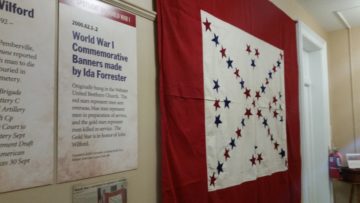
Gold Star Mother quilt on display
Hartlerode is hoping the WWI exhibit carries a message for today despite its 100-year-old origins.
“This should get us thinking,” she said. “I’m hoping they feel some empathy for people from Wood County who served. Average people can make a difference.”
In some cases, visitors who don’t even realize they have ancestors who served may find their family members in the binders of soldiers, she said.
In addition to this being the first time the museum has dedicated its entire space to one exhibit, this is also the first time the historical center can offer its guests better accessibility with its new elevator now in operation.
“People are excited about the improvements we made at the museum,” Hartlerode said.

